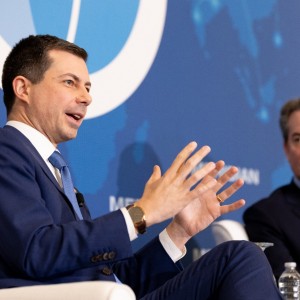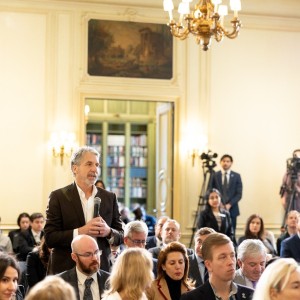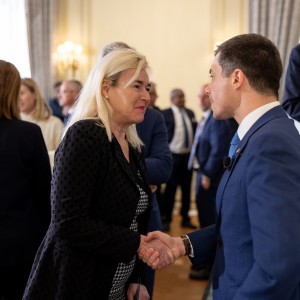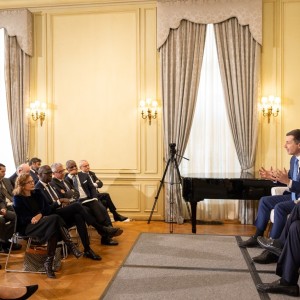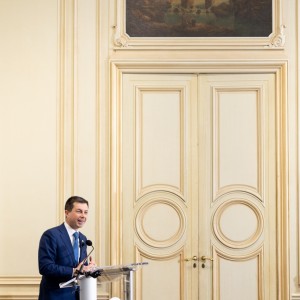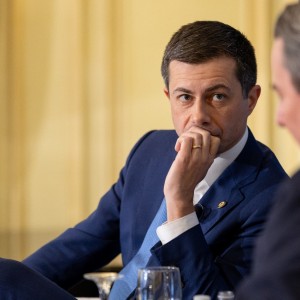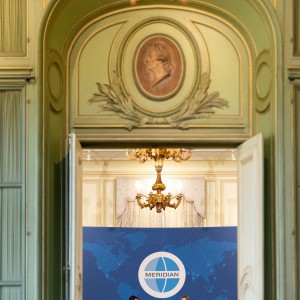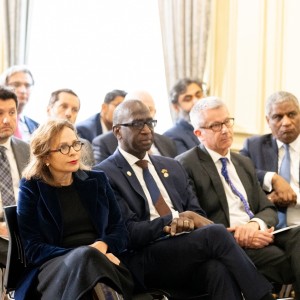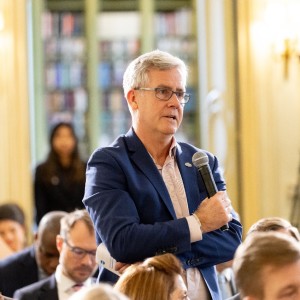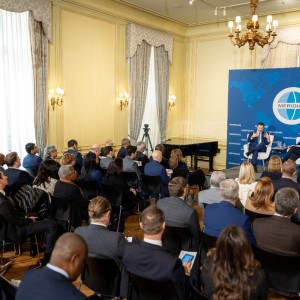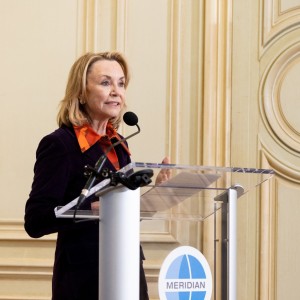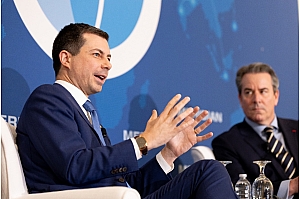Planes, Trains, Drones and Autonomous Automobiles: Insights@Meridian with The Honorable Pete Buttigieg

Advancing infrastructure is paramount to strengthening U.S. economic competitiveness, fostering job creation, and facilitating decarbonization towards new energy solutions. As the world grapples with the pressing challenges of climate change and urban congestion, the need for modernizing global transportation systems has never been greater. Shifting societal demands and technological advancements require forward-thinking approaches and collaborative efforts to shape a more efficient, inclusive, and resilient transportation landscape.
On February 16, 2024, Meridian hosted The Honorable Pete Buttigieg, United States Secretary of Transportation, for an Insights@Meridian discussion facilitated by Ambassador Stuart Holliday, CEO at Meridian, on the pioneering strategies driving our nation’s transportation agenda forward. Megan Beyer, Meridian Trustee and Director of the Office of Art in Embassies at the U.S. Department of State, delivered welcoming remarks.
Here are some top takeaways from the program:
1. A Vast Portfolio
The Department of Transportation looks a bit different today than it did in 1966, when it was founded by President Lyndon B. Johnson at the behest of Najeeb Halaby, chief of the then-independent Federal Aviation Agency. What began as a push to improve national coordination on transportation-related matters has since developed into a department at the frontlines of economic, climate, and security policy. To begin the program, Secretary Buttigieg provided an overview of the Department’s current agencies and core functions. He highlighted the department’s more obvious portfolios, like rail, transit, and—most notably—aerospace. The Federal Aviation Administration (FAA) is larger than the rest of the department combined and oversees portfolios ranging from pilot’s licenses to the commercial space transportation industry. However, the Department of Transportation is also comprised of agencies such as the Pipeline and Hazardous Materials Safety Administration and the Great Lakes St. Lawrence Seaway Development Corporation, which operates the United States-Canadian St. Lawrence Seaway in partnership with its Canadian sister organization.
2. Build, Run, Protect
The Department of Transportation operates around three core pillars: build, run, and protect. “Build” refers to infrastructure construction and maintenance projects. The Department is not directly involved in infrastructure construction. Instead, it funds state agencies, transit authorities, and airports through grants; these local actors are then responsible for awarding contracts to firms depending on their project’s needs. The second pillar, “run,” applies to America’s air traffic system, which is wholly owned and operated by the Department of Transportation. Finally, “protect” represents the Department’s obligation to regulate our country’s transportation networks. Although railroads and highways are not run by the Federal government, the Department is tasked with implementing the regulations needed to keep travelers safe.
3. Learning from Other Countries
Secretary Buttigieg identified key areas in which the United States can learn from its allies abroad. One area is project delivery. Buttigieg stressed that improving efficiency, even by 1%, adds up; for a trillion-dollar bill like the Bipartisan Infrastructure Law, 1% translates to $10 billion in value. The White House acknowledged that the United States lags peers like Canada, the U.K., and Australia in delivering on-time and on-budget infrastructure projects. By leveraging knowledge networks across borders, America will be better equipped to assess gaps in its current approach to infrastructure development. Commuter- and climate-forward infrastructure is the second area. Secretary Buttigieg referenced his visit to Amsterdam, where he witnessed firsthand how “a series of policy choices that were made to make sure that it was safer and more efficient [for bikers]” changed the landscape of the city from being made for cars, to the current commuter and climate-friendly model it is today. With walk and bike lanes being a key component of the Bipartisan Infrastructure Law, the Biden-Harris Administration is continuing to learn from and implement best practices from its international partners to make cities safer for bikers and greener for climate.
4. International Cooperation on Key Issues
As is the case in many countries, the transportation industry is the largest contributor of greenhouse gas emissions in the United States. With infrastructure around the world decaying due to unprecedented climate events, Buttigieg emphasized “it is inevitably the case that every transportation policy decision is also a decision about climate policy.” This is why cooperation on sustainable transportation systems provides a promising opportunity for the international community to generate innovative, comprehensive solutions. Secretary Buttigieg emphasized the importance of multilateral engagement on climate through institutions like the G7 or COP. Buttigieg also listed sustainable aviation as one key area of international climate collaboration, touting the International Civil Aviation Organization’s Carbon Offsetting and Reduction Scheme for International Aviation (CORSIA) for its cooperative approach to global environmental regulation.
5. Supply Chains
“Not a household term three- or four-years ago,” in a post-COVID world, supply chains are now “kitchen-table talk,” remarked Secretary Buttigieg. With the Department of Transportation overseeing the air, maritime, and land routes that make up the United States’ supply chains, Buttigieg acknowledged the topic’s increased relevance to the lives of everyday Americans. When asked how China’s aggressive positioning in nickel and lithium markets is affecting the United States’ ability to expand electric vehicle access, Buttigieg referenced how the Department of Transportation is closely collaborating with the Department of Energy on the issue. The Joint Office of Energy and Transportation was established by the Bipartisan Infrastructure Law in 2021 with the goal of deploying accessible and equitable zero-emission transportation infrastructure. Buttigieg expressed confidence in the United States’ ability to insulate EV supply chains by onshoring or “friendshoring” key materials.
6. The Future of Transportation Technology
Secretary Buttigieg was also asked about the potential for the Department to leverage generative AI across its work. One area that he was optimistic about was project delivery. AI has the potential to help bypass time-consuming and effort-intensive administrative processes. This would be especially beneficial to smaller communities, who often struggle to navigate the bureaucracy that comes with navigating transportation permits. Buttigieg was also hopeful about the role that AI could play in improving driving safety and reducing vehicle-related deaths. Albeit cautious of automated technologies currently on the market, Buttigieg expects forthcoming innovations to continue to improve public safety on the road. Finally, he pointed out AI’s potential for continued improvements in air travel—both in assisting the FAA to secure American airspace and simplifying airline travel for passengers.
Project summary
| Planes, Trains, Drones and Autonomous Automobiles: Insights@Meridian with The Honorable Pete Buttigieg | February 2024 | |
|---|---|
| Impact Areas: | Transportation |
| Program Areas: | Diplomatic Engagement |
| Partners: | Diplomatic Corps, Individuals/Donors, Private Sector, NGOs, Public Sector |
